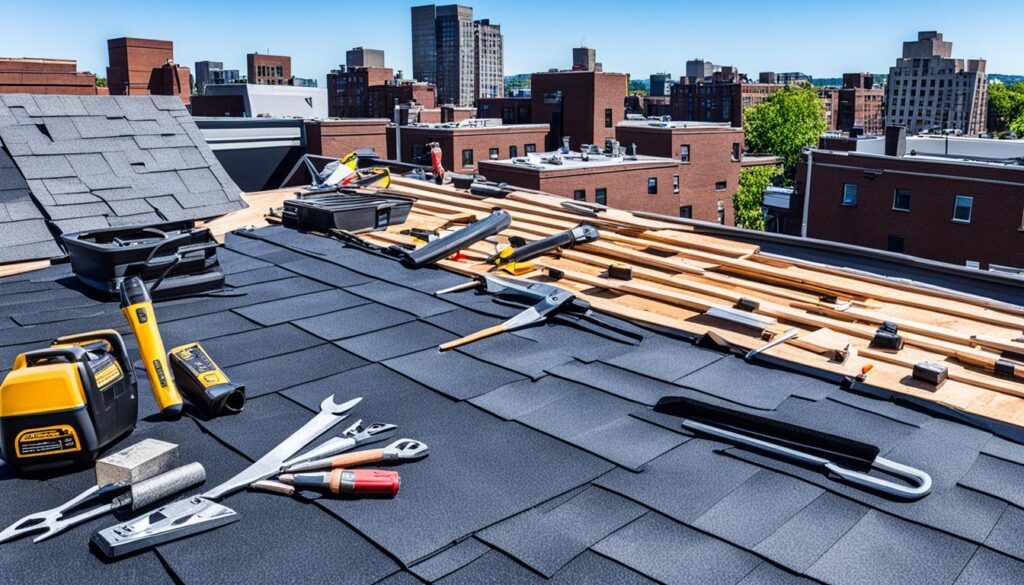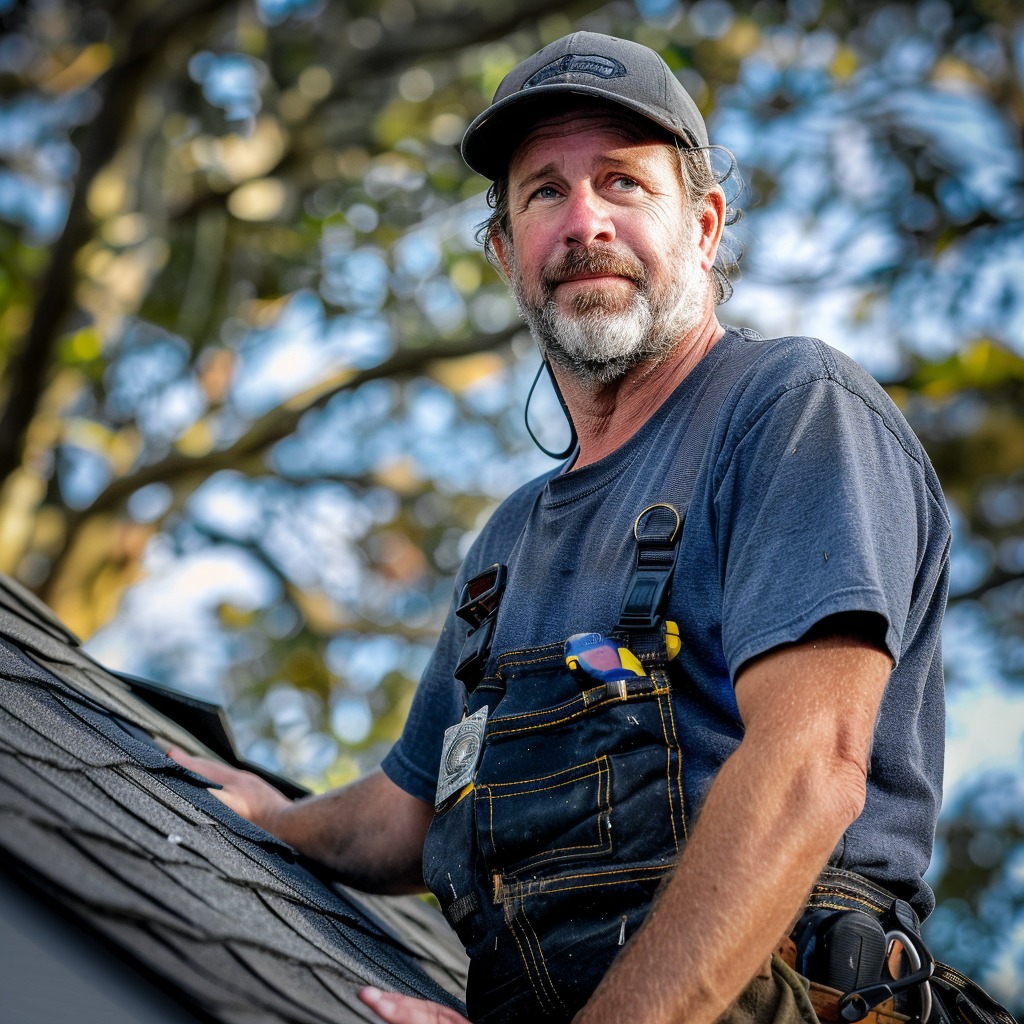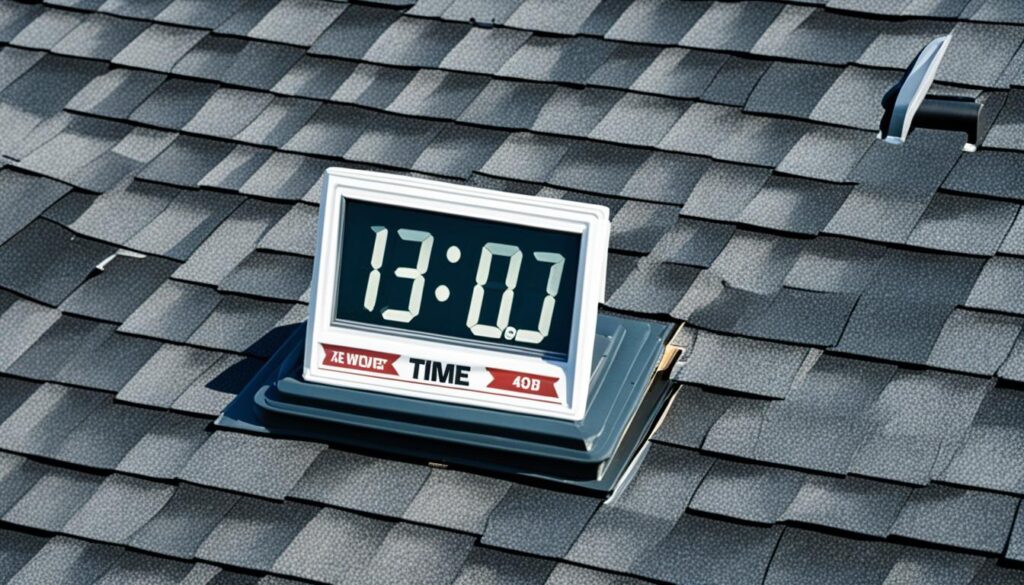How long does it take to replace a roof? If you’ve ever wondered about the average duration for roof replacement, you’re not alone. Many homeowners are curious about the timeline for this significant home improvement project. While there isn’t a one-size-fits-all answer, there are several factors that can affect the length of a roof replacement. Let’s explore the typical roof replacement timeline, the variables that impact it, and why timely roof replacement is crucial.
- The average roof replacement time can vary depending on factors such as the size and complexity of the roof, weather conditions, and the chosen roofing material.
- Typically, an average-sized home can have its roof replaced in a day, while larger homes may take two to three days.
- Timely roof replacement is important for preventing further damage, saving money, and ensuring the safety of the home and its occupants.
- The lifespan of different roofing materials should be considered when planning a roof replacement project.
- Understanding the factors that influence roof replacement time can help homeowners make informed decisions and choose a reliable roofing contractor.
Factors That Affect the Length of a Roof Replacement
Several factors can influence the length of a roof replacement project. The size and complexity of the roof are significant factors, as larger and more complex roofs will naturally take longer to replace. The weather and time of year also play a role, as the amount of daylight available and the temperature can impact work hours and shingle installation. The condition of the roof is another factor, as additional time may be needed to address any damage or rot in the roof decking.
It’s important for homeowners to consider these factors when estimating the timeline for their roof replacement project.
Size and Complexity of the Roof
The size and complexity of the roof are key variables impacting roof replacement duration. Larger roofs with multiple levels, intricate architectural features, and complex designs require more time and effort to replace than smaller, simpler roofs.
Weather and Time of Year
The weather and time of year can significantly affect the timeline of a roof replacement. Extreme weather conditions such as heavy rain, snowstorms, or high winds can delay the project and extend the overall duration. Additionally, the amount of daylight available during shorter winter days can limit work hours, while hot summer temperatures can impact the installation of roofing materials.
Condition of the Roof
The condition of the roof is another critical factor that can influence the length of a roof replacement. If there is underlying damage or rot in the roof decking, additional time may be needed to address these issues before the replacement can proceed. Identifying and addressing any structural issues or repairs can extend the duration of the project.
By considering these factors, homeowners can better understand the variables impacting the length of their roof replacement and develop more realistic expectations for the project timeline.
Average Roof Replacement Timeline by Material
When it comes to roof replacement, the material used can significantly impact the duration of the project. Here’s a breakdown of the average replacement time by roofing material:
Roofing Material
Duration of Replacement
Roofing Material Duration of Replacement Asphalt Shingles 15 to 30 years Architectural Shingles 25 to 30 years Wood Shingles 15 to 30 years Clay or Concrete Tiles 50 years or longer Metal Roofs Up to 70 years Slate Tile Roofs A century or longer
Asphalt shingles, which are the most common roofing material, typically last between 15 to 30 years. Architectural shingles, a premium type of asphalt shingle, have a similar lifespan of 25 to 30 years. Wood shingles also have a lifespan of 15 to 30 years. On the other hand, clay or concrete tiles can last 50 years or longer. Metal roofs have a lifespan of up to 70 years, while slate tile roofs can last a century or longer.
When planning for a roof replacement, it’s essential to consider the current material of your roof and its expected lifespan. Investing in a long-lasting material can help extend the time between replacement projects and provide enhanced durability for your home.
Timely Roof Replacement’s Importance
Timely roof replacement is important for several reasons. First and foremost, it helps prevent further damage to the home and can save homeowners money in the long run. By addressing roof issues promptly, homeowners can avoid costly repairs caused by water leaks and potential mold growth. Timely roof replacement also helps maintain the structural integrity of the home and ensures the safety of the occupants. Additionally, investing in a new roof when necessary can help homeowners avoid frequent repairs and maintenance expenses, resulting in long-term cost savings.
When a roof is nearing the end of its lifespan, it may start to show signs of deterioration, such as missing or damaged shingles, leaks, or sagging. Ignoring these signs and delaying the replacement can lead to more severe issues, including structural damage to the home’s interior, rotting of the roof deck, and even the potential for roof collapse. Taking proactive measures and replacing a roof in a timely manner can help homeowners avoid these costly and dangerous situations.
“Ensuring that your roof is in good condition through timely replacement is not just a matter of aesthetics; it’s about protecting your home investment and the people who live in it.”
A well-maintained roof is also important for energy efficiency. An aging or damaged roof can result in heat loss during the winter and heat gain during the summer, causing increased energy consumption and higher utility bills. By replacing the roof on time, homeowners can improve the insulation and ventilation of their homes, leading to better energy efficiency and reduced energy costs.
Moreover, a new roof can enhance the curb appeal of a home and increase its market value. A visually appealing and well-maintained roof adds to the overall attractiveness of a property and makes a positive impression on potential buyers. Whether homeowners plan to sell their property in the near future or not, investing in a new roof can provide significant returns in terms of aesthetics and property value.
In summary, the importance of timely roof replacement cannot be overstated. It helps prevent further damage, saves money in the long run, maintains the structural integrity of the home, ensures the safety of occupants, improves energy efficiency, and enhances the overall value of the property. Homeowners should prioritize regular roof inspections and take prompt action when it comes to replacing their roof to enjoy these numerous benefits.
Lifespan of Different Roofing Materials
When planning for a roof replacement, it’s essential to consider the lifespan of the different roofing materials. Each type of roofing material has a distinct durability and can significantly impact the longevity of your roof. Understanding the lifespan of these materials can help you make an informed decision about which one is right for your home.
Here is an overview of the average lifespan of common roofing materials:
| Roofing Material | Lifespan |
|---|---|
| Asphalt Shingles | 15 to 30 years |
| Architectural Shingles | 25 to 30 years |
| Wood Shingles | 15 to 30 years |
| Clay or Concrete Tiles | 50 years or longer |
| Metal Roofs | Up to 70 years |
| Slate Tile Roofs | A century or longer |
It’s important to note that these are average lifespan estimates and can vary based on various factors such as maintenance, climate, and installation quality. Regular inspections and proper maintenance can help extend the lifespan of your roof.
Considering the expected lifespan of each roofing material is crucial when planning a replacement project. By selecting a material with a longer lifespan, you can save money and avoid having to replace your roof again in the near future.
Image:

Considerations for Roof Replacement
When it comes to planning for a roof replacement, there are several important factors that homeowners should consider. Taking these factors into account can help ensure a successful and smooth roof replacement project. Here are the key considerations:
- Size and Complexity of the Roof: The size and complexity of the roof play a significant role in determining the time and resources required for the replacement. Larger and more complex roofs may need additional time, materials, and labor.
- Weather and Time of Year: The weather conditions and time of year can impact the installation process. Extreme temperatures, heavy rain, or snow can affect the roof replacement timeline. It’s important to choose a suitable time when the weather conditions are favorable.
- Condition of the Roof: Before starting the replacement, it’s essential to assess the condition of the existing roof. Any underlying damage, rot, or structural issues should be addressed before the replacement can take place. This ensures a solid foundation and reduces the risk of future problems.
By carefully evaluating these considerations, homeowners can make informed decisions that align with their specific needs and expectations. It’s recommended to consult with a reputable roofing contractor who can provide expert guidance based on the individual circumstances of the roof.

The Roof Replacement Process
The roof replacement process involves several important steps that homeowners should be aware of. Understanding what happens during a roof replacement can help ensure a successful project and provide peace of mind.
Step 1: Preparation
Prior to starting the roof replacement, the roofing crew will prepare the house. This involves tarping sensitive areas, such as windows and landscaping, to protect them from debris and potential damage. The work area will also be cleared to provide a safe and organized space for the project.
Step 2: Tear-Off
The tear-off process is the removal of the old shingles and materials from the roof. This step is crucial for assessing the condition of the roof decking and ensuring a clean surface for the new roof installation. Any damaged decking will be replaced at this stage.
Step 3: Installation of a Full Roofing System
Once the tear-off is complete, the crew will proceed with installing a full roofing system. This includes various components to ensure the durability and effectiveness of the new roof. The following elements are typically included:
- Drip Edge: A metal strip that helps redirect water away from the fascia and protects the edges of the roof.
- Ice & Water Shield: A waterproof membrane that prevents water infiltration in areas susceptible to ice dams or heavy rain.
- Flashing: Metal pieces that are installed in vulnerable areas, such as chimneys, skylights, and vent pipes, to prevent water leaks.
- Underlayment: A layer of material, usually felt or synthetic, that provides an additional barrier against water penetration.
- Starter Shingles: Shingles specifically designed for the first row of the roof, offering an extra layer of protection against wind uplift.
- Main Shingles: The primary roofing material chosen by the homeowner, whether it’s asphalt, wood, metal, clay, or another option.
- Ridge Cap: Specialized shingles or metal caps that cover the ridge of the roof, providing a finished and weatherproof edge.
Step 4: Clean-Up and Debris Removal
After the installation is complete, the roofing crew will conduct a thorough clean-up of the work area. Debris, such as old shingles and packaging materials, will be removed from the property. This ensures that the property is left clean and free from potentially hazardous materials.
To visualize the roof replacement process, take a look at this image:
These steps provide a general overview of the roof replacement process. Keep in mind that the duration and specific details may vary depending on the size of the roof, the chosen roofing material, and any additional complexities or considerations specific to the project.
Conclusion
In conclusion, the average roof replacement time can vary depending on several factors, such as the size and complexity of the roof, weather conditions, and the chosen roofing material. Homeowners planning for a roof replacement project should carefully consider these factors and select a reliable roofing contractor to ensure a smooth and efficient process.
Timely roof replacement is crucial to prevent further damage to the home, save money in the long run, and ensure the safety of the occupants. By addressing roof issues promptly, homeowners can avoid costly repairs caused by water leaks and potential mold growth. Investing in a new roof when necessary can also help minimize frequent repairs and maintenance expenses, resulting in long-term cost savings.
Understanding the average roof replacement time and the factors that can influence it empowers homeowners to make informed decisions when it comes to their roofing upgrades. By taking these key takeaways into account, homeowners can plan and execute a successful roof replacement project that enhances the overall value, comfort, and longevity of their home.

Meet William Adams, a seasoned roofing expert with over 30 years of hands-on experience in the industry. Having worked tirelessly under the scorching sun and through the fiercest storms, William brings a wealth of knowledge and expertise to the table. Hailing from the heart of the USA, he’s witnessed the evolution of roofing practices firsthand, mastering every aspect along the way. Now retired from the field, William spends his days cherishing time with his loved ones while sharing his invaluable insights through this platform. With William at the helm, you can trust that every tip, advice, and recommendation provided is backed by years of real-world experience and unwavering dedication to quality craftsmanship. Join us as we journey through the world of roofing, guided by the wisdom and passion of a true industry veteran.

